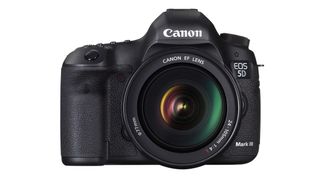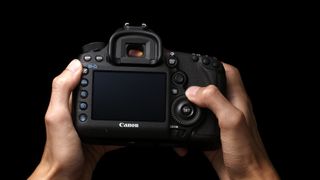TechRadar Verdict
It may have been replaced by the Mark IV, but the Mark III is still a great choice for those after a feature-packed full-frame DSLR.
Pros
- +
Excellent HDR mode
- +
Detailed raw and JPG files
- +
High quality images
- +
Low noise
Cons
- -
Complicated AF system
- -
A bit pricey
Why you can trust TechRadar
Canon's EOS 5D Mark III has a lot to live up to. For a start, the original Canon EOS 5D was the first DSLR to really bring full-frame digital photography within the reach of enthusiast photographers. Then came its replacement, the Canon EOS 5D Mark II, which kick-started the current trend for shooting video on a DSLR.
So naturally, as the 5D Mark II clocked up its third birthday in September 2011, the rumour mill slipped into overdrive with lots of speculation about the likely specification of the 5D Mark III.
While it might not have the headline-grabbing 36MP pixel count of the Nikon D810, Canon's latest full-frame camera has lots to offer enthusiast photographers.
Features
- Full-frame CMOS sensor, 22.3MP
- 3.2-inch screen, 1,040,000 dots
- 1080p video capture
With 22.3 million effective pixels, the Canon EOS 5D Mark III's sensor only has 1.2MP more than the 21.1MP Canon EOS 5D Mark II that it replaces, but it has 4.2MP more than the 18.1MP Canon EOS-1D X at the top of Canon's DSLR line-up.
Whereas the Canon EOS-1D X has two DIGIC 5+ processors, the 5D Mark III has one, which in combination with its eight-channel readout means that it has a top continuous shooting speed of 6fps.

This is half the rate of Canon's top-end camera, and it may disappoint those hoping for something in the region of 8fps or more. It's a big jump from the 3.9fps of the Canon 5D Mark II, though, and the burst depth is an impressive 18 raw images or 16,270 JPEGs (when a UDMA 7 card is used).
Sensitivity may be set in the range of ISO100-25,600 in 1/3-stop or whole stop increments, and it can be expanded to include L: ISO 50, H1: ISO 51200, H2 ISO102,400.
Predictably, Canon has upgraded the metering system to its iFCL metering. Existing Canon EOS 5D Mark II users may find it takes a little getting used to as it reacts in a similar way to centre-weighted metering and puts greater emphasis on the subject under the active AF point.
In some situations this is a blessing, but with exceptionally dark or light main subjects the results may not be the same as the Canon EOS 5D Mark II would produce in its evaluative metering mode.
Its video capability was one of the big successes of the Canon EOS 5D Mark II, and Canon hasn't changed much of its specification for the Mark III version, but there are some significant improvements.
Firstly there's the introduction of a live view/movie switch on the rear, like on the Canon EOS 7D, to speed up movie activation.
There's also a headphone socket for monitoring the stereo audio, which can be adjusted in the same way as that on the Canon EOS-1D X.

Until now Canon hasn't had a DSLR with in-camera HDR recording, but the Canon EOS 5D Mark III is capable of recording and merging three shots to produce a high dynamic range image.
This is extremely useful, since it records all three shots as well as the processed HDR image, and if you shoot raw and JPEG images simultaneously, you'll find you have a total of seven images, including three raw files that you can process yourself if you wish.
Another difference between the Mark II and III versions of the Canon EOS 5D is that the newer camera has two card ports, one for compact flash and the other for SD format cards. There's no XQD card port.

New Androxgh0st botnet targets vulnerabilities in IoT devices and web applications via Mozi integration

TrueNAS device vulnerabilities exposed during hacking competition

Could this be Dell's fastest laptop ever built? Dell Pro Max 18 Plus set to have 'RTX 5000 class' GPU capabilities and Tandem OLED display
